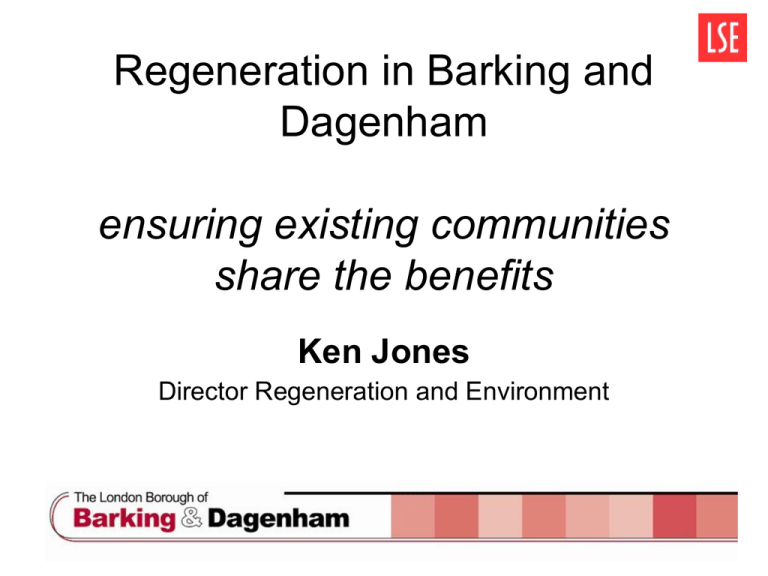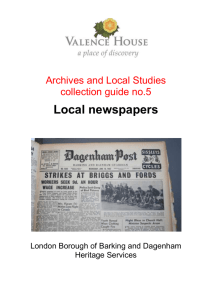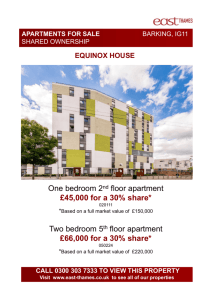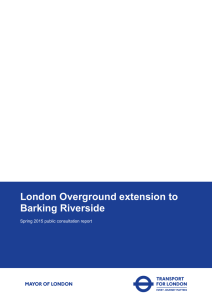Regeneration in Barking and Dagenham ensuring existing communities share the benefits
advertisement

Regeneration in Barking and Dagenham ensuring existing communities share the benefits Ken Jones Director Regeneration and Environment Location of Barking and Dagenham Borough Profile • Borough has 164,000 - 56% employed and 11% retired • 85% of population is white • Teenage pregnancy - under 18 conception rate (2001-2003) – B&D 69.6% – London 42.4% • Borough contains two wards in the 10% most deprived in England Borough Profile • • • • low skills levels lowest average income in London lowest house prices in London second highest percentage of social rented homes in outer London (38%) Political Makeup of Council Labour Conservative Residents Labour Co-op Liberal Democrats Industrial Background • rich industrial heritage – 1931 Fords car production started (34,000 employed) – Production ceased 20/2/02 – 1934 May and Baker pharmaceuticals (now Aventis) • globalised economy – Skills bank does not match new service sector economy Skills • low skill base means that local people will not be able to benefit from the higher value new jobs created • increased polarisation between existing and new communities • repetition in future generations of economic and social deprivation Schools’ Performance • The percentage of GCSE students gaining five or more grades A* to C in 2005 rose 7.7% compared to 2002, beating the national average rise of 4.7%. • With 90.8% of the Borough's GCSE students getting five or more grades A* to G, this figure is also above the national average. Employment activity over time Comparisons Qualifications for B&D Education Attainment by Age Group 35.00% Percentage of Age Group 30.00% 25.00% 20.00% People 30 to 49 15.00% People 20 to 29 10.00% 5.00% 0.00% No Qual Level 1 Level 2 Level 3 Level of Attainment Level 4/5 Other Qual Upskilling • 15.8% 16-19 year olds Not in Education Employment or Training, higher than Learning and Skills Council East (11%). To be reduced by 20% by 2010 ( Government Target) • Over half (57%) of working age residents do not have a qualification of Level 2 or above, BUT … • 60% of the 194,000 additional permanent jobs created by 2016 across the Thames Gateway will be at Level 3 or above • Even within construction, some 75,000 jobs will require at least a Level 3 qualification. (Thames Gateway Skills Audit) Rates of change Population Change - Asian Population Change - Black B&D BME Population Percentage of Pop 16-74 qualified to degree level. Ethnicity • Ethnicity and degree level qualifications linked • Increased BME representation in west of Borough • BME population projected to increase • Council needs to facilitate change and assist community cohesion Potential • A central location in the central location in the Thames Gateway • Excellent road and rail transport • The largest brownfield sites in the UK at Barking Riverside and South Dagenham • An existing Town Centre, ripe for renewal • Waterfront sites for housing development along the Thames and River Roding • A rapidly improving Council building a solid base for both existing and future generations Sites of Opportunity Physical regeneration will focus on four major sites: • Barking Town Centre – 4,000 new homes, with new shops, community and leisure facilities and a creative industries’ “hub”, • Barking Riverside - 10,700 new homes, with schools, medical facilities, parks and DLR stations • South Dagenham - 6,000 new homes, retail and business development • Dagenham Dock - a Sustainable Industrial Park and the Environmental Technology Centre for London New jobs, new households • Creation of 15,000 new jobs which requires improved choice and quality of housing • 26,000 new homes over 20 years • Mixed tenure comprising of affordable and private sale housing • New developments have a significant percentage of affordable housing incorporating key worker, shared ownership, sub-market rented and socially rented. • Approximate breakdowns for Town Centre Developments Social rented 1605 23% Intermediate Tenures 1930 27% Private Sale 3550 50% from tower blocks…… …..to Gateway Site foyer proposal Building communities – changing lives • delivery of social infrastructure and public transport • investing in existing communities to eliminate ‘cliff edges’ • build out from existing Barking Town Centre – where there is a sense of place • costs of failure – social cohesion Eliminating barriers • Council and Jobcentre Plus closer partnership – recruit locally and target under represented groups, especially the young. • Council to actively use Planning Advice Note 2 - Local Labour and Local Business Agreements • Section 106 agreements to focus on construction apprenticeships, support residents into this in collaboration with Barking College and other key partners • More provision for vocational course 14-19 age group. • Barking and Dagenham partnership bid for LEGI. Building sustainable communities: Barking Riverside • • Our aim is to create socially, economically and environmentally sustainable new communities. Barking Riverside will see 10,700 new homes, with schools, medical facilities, parks and access to the Thames. The Docklands Light Railway and East London Transit will link Barking Riverside to the rest of London. Summary • Imperative that local communities share the benefits of regeneration • By • • • • • increasing skills – increased income greater enterprise, economic activity – more jobs new homes – wider housing choice and tenure mix social infrastructure community cohesion Ken Jones Director Regeneration and Environment






